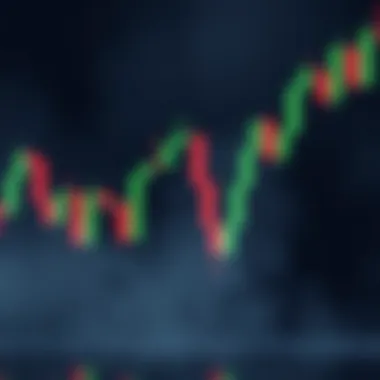Top Candlestick Patterns for Successful Swing Trading


Intro
Swing trading embodies a strategy that many traders, especially within the cryptocurrency space, find crucial for navigating the often tumultuous markets. It’s the sort of approach that seeks to capitalize on price movements over a few days to weeks, rather than clinging to positions for months or just minutes. In this landscape, candlestick patterns emerge as essential tools. These patterns are not merely visual representations of price action; they encapsulate the psychology behind trading decisions, offering insights into potential market shifts.
Understanding these patterns is akin to reading the pulse of the market. Each candlestick can tell a story — it reflects the battle of supply and demand during a specific timeframe. Thus, if you're looking to fine-tune your swing trading skills, grasping how these patterns function is non-negotiable. This article will shine a light on some of the most effective candlestick patterns, providing you with the knowledge necessary to interpret their implications and improve your trading decisions.
Key Concepts in Cryptocurrency
Understanding Blockchain Technology
Before diving into candlestick patterns, it’s fundamental to grasp the underlying technology of cryptocurrencies. Blockchain technology serves as the backbone of crypto assets. This distributed ledger technology not only ensures the integrity of transactions but also introduces features such as transparency and security that are unprecedented in the financial world.
Familiarity with blockchain can bolster your understanding of market movements, as price fluctuations often correlate with broader changes in network activity or sentiment within the community. A trader who knows when high transaction volumes are supporting an upward price trend, for instance, is better equipped to identify potential swing opportunities.
The Role of Smart Contracts
Smart contracts are another vital component to consider. They automate processes and agreements between parties without the need for intermediaries. This not only streamlines operations but can lead to faster settlements and lower transaction costs. Understanding how smart contracts function can provide insight into specific projects, enabling traders to align their strategy with potential market moves.
By broadening your knowledge about these foundational elements, you can appreciate the volatility that often characterizes cryptocurrencies and better navigate the swings that follow market trends.
Market Trends and Analysis
Current Market Dynamics
The cryptocurrency market is notoriously volatile, exhibiting swings that are often driven by both macroeconomic factors and community sentiment. Analyzing these dynamics is essential for swing traders seeking to capitalize on short to medium-term movements. Price surges linked to news reports or influencer endorsements might create aggressive buy signals that can influence candlestick patterns significantly.
Researching market data and trends can inform your understanding of these candlestick formations. For example, the appearance of a specific bullish pattern might coincide with a significant technological advancement announced by a leading crypto organization.
Predictions for Emerging Cryptocurrencies
Being ahead of the curve requires not just an awareness of present market conditions but also a forward-looking approach. Emerging cryptocurrencies often generate considerable buzz, and their associated candlestick patterns can help predict potential price movements. Keeping an eye on new developments and forecasts can reveal hidden opportunities, allowing you to position yourself strategically.
Remember: The ability to interpret candlestick patterns in conjunction with understanding market trends will create a formidable advantage in your swing trading journey.
Stay tuned as we progressively dissect specific candlestick patterns that are vital for any swing trader.
Prelims to Candlestick Patterns
Candlestick patterns offer traders a unique glimpse into market sentiment and price behavior. Their importance cannot be overstated, especially for swing traders. Understanding these patterns helps in identifying potential reversal points and trend continuations which can be crucial for making informed decisions in short to medium term trading. These patterns are more than just symbols on a chart; they represent the battle between buyers and sellers, reflecting the underlying psychology of the market. When a bullish or bearish candlestick forms, it tells a story of how traders are reacting to various factors, including news events, economic data, and market rumors.
Understanding Candlestick Charts
A candlestick chart provides a visual representation of price movements over specific time frames. Each candlestick is composed of a body and wicks (or shadows). The body represents the open and close prices, while the wicks indicate the high and low prices during the time frame it represents. For instance, a long body signifies strong buying or selling pressure, while a short body implies indecision in the market. To comprehend these charts fully, a trader should pay attention to color; typically, a green candle indicates a bullish movement, signaling that buyers were dominant, while a red candle shows a bearish move, indicating seller strength.
To better analyze the market, swing traders often combine candlestick patterns with other tools such as trend lines and indicators. By doing this, they create a broader picture of market conditions. Patterns such as hammers, dojis, and engulfing formations can appear on the chart, each carrying unique implications and potential trading signals. The nuances in candlestick formations reveal important insights into market sentiment, allowing traders to make better decisions. Accordingly, trading strategies are often anchored on the identification and interpretation of these patterns.
Importance in Swing Trading
Swing trading thrives on capturing short-term fluctuations in the market. This trading style seeks to exploit price swings, often holding onto positions from a few days to several weeks. The identification of candlestick patterns is crucial here, as they serve as indicators of potential market moves. For example, a well-formed hammer or an engulfing pattern can suggest that a reversal may be imminent, allowing traders to position themselves accordingly.
In the volatile world of cryptocurrency, where emotions often run high, understanding these patterns becomes even more vital. Market conditions can change drastically overnight, and traders need reliable tools to navigate these shifts. With a solid grasp of candlestick patterns, swing traders can better anticipate movements, improve their entry and exit points, and enhance their overall risk management.
"In trading, knowledge is more than a tool; it's the foundation on which strategies are built."
Harnessing candlestick patterns can potentially provide an edge in the fast-paced crypto markets. By paying close attention to price action, volume, and specific candlestick formations, swing traders can better align their strategies with market dynamics. This approach will ultimately lead to more informed, confident trading decisions.
Key Candlestick Patterns


Understanding candlestick patterns is crucial for any swing trader. These formations provide not only visual cues about market sentiment but also a way to anticipate potential price movements. The ability to recognize and interpret these patterns can offer traders a significant edge in understanding market dynamics, especially in the highly volatile crypto landscape. Studying these patterns can sharpen a trader's intuition, leading to better decision-making and higher profitability.
Bullish Patterns
Bullish patterns indicate a potential upward trend in the price of an asset. Recognizing these formations helps traders position themselves to take advantage of market upswings.
Long White Candle
The Long White Candle is characterized by its length and color—it’s a candle where the opening price is significantly lower than the closing price. This pattern does more than just tell traders that the price went up; it screams bullish momentum. Traders often look for candlestick patterns like this one because it can signal a strong buying interest in the market.
One key characteristic of the Long White Candle is its ability to denote a confident rally. When this candle appears after a series of down candles, it can indicate a possible trend reversal, making it a popular choice among traders aiming for timely entries. However, if the market is experiencing turbulence, relying solely on this pattern may lead to pitfalls, as false signals can crop up in uncertain market conditions.
Hammer
The Hammer is a candle that appears at the end of downtrends, signifying a potential reversal. Its appearance—a small body at the top with a long lower shadow—hints at buyers stepping in to support the price. For traders, this pattern symbolizes hope, as it suggests that further declines may be limited.
A defining feature of the Hammer is its psychological implication: sellers pushed the price lower, but buyers fought back, bringing it back up. This duality of power often leads to bullish momentum, making it a popular choice for swing traders looking to capitalize on rebound opportunities. Nevertheless, it's imperative to confirm this pattern with additional indicators, as sometimes the market can appear deceptively optimistic.
Morning Star
The Morning Star is a three-candle pattern indicating a strong potential for price reversal from bearish to bullish. Its structure includes a long bearish candle followed by a small-bodied candle (which might be bullish or bearish) and finishing with a long bullish candle. This pattern signifies a shift in momentum that traders can keenly watch.
The Morning Star is significant due to its clear visual cues and the assurance it gives traders. The first candle shows the existing bearish trend, while the small-bodied candle reflects indecision before the third candle expresses definitive bullish sentiment. Yet, like its counterparts, traders must pay attention to market context; a Morning Star appearing in a declining market may still face resistance.
Bearish Patterns
Bearish patterns suggest declining price action, which can alert traders to potential sell opportunities.
Long Black Candle
The Long Black Candle paints a vivid picture of heavy selling pressure. It typically features a long body colored black or red, indicating that the closing price was significantly lower than the opening price. Often seen as a clear signal of downward momentum, traders pay close attention when this pattern emerges, particularly following an uptrend.
This candle’s defining characteristic lies in its depiction of aggressiveness from sellers, creating an environment where buyers may think twice. Traders often see it as a hint to lock in profits before a potential downward spiral. However, just as a coin has two sides, it's crucial to consider market context; a Long Black Candle amidst a solid uptrend might merely signal a pullback rather than the beginning of a downtrend.
Shooting Star
The Shooting Star pattern appears at the top of an uptrend and suggests that buyers failed to maintain higher prices, leading to a bearish reversal. With a small body at the bottom and a long upper shadow, this candle presents a stark warning signal for traders who are long in the market.
This pattern's power lies in its ability to demonstrate buyer exhaustion. For swing traders, spotting a Shooting Star can be an opportunity to short or exit positions. Still, exercising caution and looking for confirmation signals following this pattern is always wise, as not all appearances guarantee immediate declines.
Evening Star
The Evening Star is another powerful three-candle bearish reversal pattern, featuring the same structure as the Morning Star but in reverse. Typically, it consists of a long bullish candle followed by a small-bodied candle and finishes with a long bearish candle.
It encapsulates the transition from bullish momentum into bearish sentiment, providing a clear indication for traders to reassess their positions. The importance of the Evening Star lies in its reliable implications, but as with all patterns, it should be confirmed with further analysis and market indicators to avoid false readings.
Reversal Patterns
Reversal patterns are crucial for swing trading as they signal shifts in market trends, giving traders the chance to reposition themselves accordingly.
Inverted Hammer
The Inverted Hammer appears during a downtrend, and its long upper wick indicates that the buyers tried to push the price higher. However, it ends with a relatively small body at the bottom. Traders often interpret this pattern as a sign that bullish sentiment may be brewing.
A key characteristic of an Inverted Hammer is its portrayal of potential trend reversal, prompting traders to look for confirmation in subsequent candles. Its distinctive shape can act as an early warning for those ready to take a risk on upward movements. However, it often needs further confirmation, as a standalone Inverted Hammer hasn’t always led to a sustainable bullish trend.
Doji
A Doji candlestick shows indecision in the market, where the opening and closing prices are nearly equal. This pattern represents a tug of war between buyers and sellers, highlighting uncertainty. While it doesn’t dictate the market direction, it can signal that a shift might be coming.


The major characteristic of the Doji is its versatility; it can appear in various market conditions. For traders, pairing a Doji with adjacent candles can provide context. A Doji set among bearish candles, for example, may point toward an impending reversal. Yet, traders must be cautious, as not all Doji formations lead to reliable signals.
Engulfing Patterns
Engulfing Patterns consist of two candlesticks where the second candle’s body completely engulfs the body of the first candle. This pattern can be either bullish or bearish, depending on the direction of the engulfing candle.
The strength of Engulfing Patterns arises from their clarity; bullish engulfing patterns can signal strong buying pressure, while bearish engulfing ones often showcase selling dominance. For traders, spotting this pattern can prompt timely actions, be it entering or exiting positions. Still, the context matters as market noise can sometimes dilute the effectiveness of the signal.
Analyzing Candlestick Patterns
Analyzing candlestick patterns is fundamental for swing trading, allowing investors to grasp the market's psychology and make more informed decisions. This section dives deep into the elements essential for understanding these patterns, showcasing how they guide actions in the fast-paced trading environment. Particularly for swing traders, recognizing price movements and understanding their context aids significantly in capturing potential profit opportunities. To get an edge, one must not only read the patterns but also understand the nuances behind price action, volume, and the significance of different time frames.
Reading Price Action
Price action refers to the movement of security prices over time. Being adept at reading price action equips traders with the ability to witness how market participants react under various conditions. This analysis helps in identifying trends and reversals quickly, forming the backbone of strategic decision-making.
For instance, consider a bullish reversal after a downturn. A trader noticing a series of candlesticks displaying higher lows, followed by a sharp increase in the price could infer that buyers are becoming more assertive, signaling a potential entry point.
Volume Analysis
Volume provides crucial context to price movements. It indicates the strength behind price actions—more volume suggests a stronger move, whereas low volume can imply weakness or a potential reversal.
When evaluating candlestick patterns, aligning them with volume helps in filtering out unreliable signals. For example, a breakout above resistance accompanied by significant volume usually strengthens the validity of that pattern. Conversely, a breakout on low volume might lead to false confidence, drawing traders into unprofitable positions.
Time Frames and Patterns
Different time frames can lead to varied interpretations of the same pattern. For swing traders, aligning the entry point with the appropriate time frame is pivotal.
Choosing the Right Time Frame
Choosing the correct time frame can make or break a trading strategy. Swing traders often select time frames that balance detail with broader trends. For example, a 4-hour chart might offer clarity on short-term trends while still aligning with the overarching daily trend. This allows traders to catch significant moves without being swayed by every minor fluctuation.
Impact of Time Frames on Reliability
The impact of time frames on reliability is particularly critical for making sound trading decisions. Patterns formed on longer time frames can often be more reliable than those on shorter charts due to the increased number of transactions and stronger market consensus.
Conversely, shorter time frames often exhibit more noise, increasing the risk of false signals. Understanding this concept helps traders filter their strategies based on reliability and improves the overall effectiveness of their trading plan.
"The key to successful trading is to find a balance between timely entries and the overall trend direction—time frames can either enhance or hinder your success."
Incorporating knowledge of time frames, volume, and price action leads to more confident trading. Analyzing these facets creates a well-rounded approach to swing trading, ensuring that the decisions made are rooted in analysis rather than speculation.
For those interested in further exploration, resources such as Investopedia or material found on Reddit can provide deeper insights into each of these components.
Strategies for Swing Trading Using Candlesticks
Swing trading is all about maximizing short- to medium-term price movements, and integrating candlestick patterns into your strategy can be a game changer. Candlestick patterns provide insights into market psychology. They allow traders to gauge potential price movements and investor sentiment, which helps in making informed trading decisions. Before entering the fray, it’s essential to develop a plan that best aligns with these patterns.
Integrating Candlestick Patterns with Indicators
When swing trading using candlestick patterns, one elemental strategy is to combine candlesticks with technical indicators. These indicators can provide additional context to the patterns you see on the chart. For example, moving averages can help confirm a trend, providing a clearer picture when you spot a potential crossover in a bullish or bearish candlestick pattern.
For instance, if a hammer pattern emerges and is accompanied by a moving average convergence, it adds weight to the bullish move projected by the hammer. This kind of synergy between indicators and candlestick patterns helps traders avoid potential false signals that can lead to losses.
Setting Entry and Exit Points
Another key aspect of swing trading is knowing when to jump in or out of a trade. This involves setting precise entry and exit points based on candlestick formations. Many experienced traders look for a confirmation candlestick after spotting a bullish or bearish pattern. For instance, if you notice a morning star pattern, they might wait for a follow-up candlestick that closes above the highest point of the pattern before making their move.
Additionally, it’s wise to establish exit points before entering a trade. This could mean predetermined profit targets or stop-loss levels. Setting this structure in advance helps protect profits and minimizes the impact of volatility. It’s essentially having a well-laid out plan.


Risk Management Techniques
No strategy is complete without sound risk management. Swing traders need a robust approach to mitigate losses, which can come unexpectedly. Here are two common techniques that stand out:
Utilizing Stop-Loss Orders
Stop-loss orders are crucial for preserving capital. By placing a stop-loss order, a trader decides in advance the amount they are willing to lose on a trade. For example, if you buy into a stock after spotting a bullish engulfing pattern, you can set a stop-loss just below the lowest price of the engulfing candle. This allows you to protect your investment and avoid bigger losses should the market turn against you.
The beauty of stop-loss orders lies in their automaticity; they execute without needing ongoing attention. This means you can sleep at night knowing that your position is safeguarded against adverse movement. While not foolproof, they are a widely accepted tool among traders.
The Role of Position Sizing
Position sizing is another vital technique in risk management. This refers to how much capital you deploy in a trade based on your risk appetite and market exposure. For example, using a fixed percentage of your trading capital on each trade can prevent significant losses in case things don’t pan out. Let’s say you have a $10,000 account and you decide to risk no more than 1% on each trade. This means your maximum risk per trade would be $100.
The unique feature of position sizing is that it allows traders to maintain consistent risk across various trades. It helps keep emotions in check and provides a buffer against the ups and downs of the market. However, it requires discipline to stick to the rules laid out in the beginning.
Position sizing and stop-loss orders are the backbone of successful risk management. Without them, swing trading can become a game of chance rather than a structured approach.
Limitations of Candlestick Patterns
Understanding the limitations of candlestick patterns is essential for traders who rely on these tools in their swing trading strategies. While these patterns can provide valuable insight into market psychology and potential price movements, they are not foolproof. Recognizing their limitations allows investors to make more informed decisions and manage risks effectively.
False Signals
One of the main drawbacks of candlestick patterns is the occurrence of false signals. This happens when a pattern suggests a particular price movement, but the market does not follow through as expected. Such situations can be frustrating for traders, leading to losses that could have been avoided with a more cautious approach.
In many cases, false signals arise from market noise. This is the short-term volatility caused by trades that don’t align with broader market trends. For instance, a shooting star candle formation that appears after a strong uptrend might give an impression of a reversal; however, if strong buying pressure from enthusiastic traders persists, it can result in a bullish continuation instead. Hence, traders should not assume that every candlestick pattern predicts a definite outcome.
Employing additional technical indicators, like moving averages or momentum indicators, can mitigate the risks connected with false signals. These extra tools can help clarify whether a candlestick pattern is likely reflecting genuine market sentiment or is merely an anomaly.
Market Conditions Impact
Volatility
Volatility is a critical aspect affecting how candlestick patterns are interpreted. In a highly volatile market environment, price fluctuations can mislead traders, making it difficult to pinpoint the significance of candlestick formations. For example, in the crypto market, where price swings can be dramatic, a bullish engulfing pattern might appear during times of extreme volatility but may not always indicate a solid trend reversal. Investors may find their trades placed in the wrong direction due to the erratic behavior of prices.
Volatility is a double-edged sword; it can present opportunities for profit, yet it elevates the risk considerably. Traders who embrace volatility must prepare for potential adverse effects on their strategies, in particular regarding entry and exit points.
Trends and Consolidations
Trends and consolidations play a significant role in determining the reliability of candlestick patterns. During strong trending markets, patterns often provide clear signals; a bullish pattern in an uptrend may indicate further price gains. On the other hand, in a consolidated market where prices range between support and resistance, candlestick formations can be much less reliable. In these scenarios, patterns may appear frequently without leading to significant price movements, leading traders to question their usefulness.
Recognizing when the market is trending versus when it's consolidating is crucial for successful trading. This recognition allows traders to adjust their strategies accordingly, enhancing the potential effectiveness of the candlestick patterns they observe.
Ultimately, while candlestick patterns can be helpful in identifying market opportunities, they are not a magic bullet. Traders should balance these patterns with an awareness of their limitations, considering other factors such as volatility and market conditions in their decision-making process. Understanding these elements can lead to more thoughtful trading strategies and improved chances of success.
Culmination
In wrapping up this discussion on candlestick patterns for swing trading, it’s essential to emphasize the multifaceted nature of these tools and their immense importance in making informed trading decisions. Understanding these patterns not only equips traders with strategies but also arms them with the intuition required to navigate the often-choppy waters of the market.
Summation of Key Insights
Reviewing the essential points covered, it becomes evident that mastery of specific candlestick patterns can significantly enhance trading acumen. Patterns like the Bullish Hammer and Bearish Shooting Star serve as indicators of potential market reversals while real-time analysis coupled with volume understanding plays a crucial role in confirming these signals. Additionally, the ability to read price action within various time frames offers critical insights into market dynamics.
"A clear grasp of candlestick formations transforms a trader’s approach from mere guesswork to informed decision-making."
As swing traders, practitioners can leverage these patterns to strategically position themselves within the market, optimizing their entry and exit points. Moreover, recognizing the limitations of these patterns, such as false signals under market volatility, prepares traders to remain vigilant and adaptable.
Future Directions in Swing Trading
Looking ahead, the landscape of swing trading is likely to evolve with technological advancements. The integration of AI and machine learning in trading strategies is becoming increasingly prominent, presenting both opportunities and challenges. Future traders may benefit from enhanced analytical tools that can predict market movements with greater accuracy based on historical data and behavioral patterns. Keeping an eye on emerging technologies will be key for traders seeking an edge.
Moreover, with the rising popularity of cryptocurrencies and digital assets, the need to adapt traditional candlestick analysis methods to these new markets is more pressing than ever. Swing traders must stay informed about evolving market structures and related regulations, ensuring their strategies remain relevant and effective.
Understanding the nuances of candlestick patterns can not only be instrumental in achieving success in swing trading but can also foster a more profound grasp of market psychology. This awareness will serve traders well, enhancing their ability to navigate market waves effectively.







